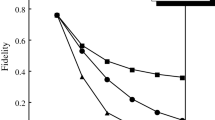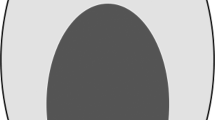Abstract
Single-qubit dissipative and non-dissipative channels, set in the general scenario of a system’s interaction with a squeezed thermal bath, are compared in the Choi isomorphism framework, to bring out their contrasting rank and geometric properties. The equivalence of commutativity between the signal states and the Kraus operators to that between the system and interaction Hamiltonian, and thus to non-dissipativeness, is pointed out. Two distinct unitarily equivalent Kraus representations of the dissipative channel, one based on the Choi isomorphism, and the other based on an ansatz, are used to illustrate that the orthogonality of Kraus operators under the Hilbert–Schmidt inner product is not a unitary invariant. Unlike the non-dissipative (Pauli) channels, the dissipative (squeezed generalized amplitude damping) channels do not form a convex set. Further, whereas the rank of Pauli channels can be any positive integer up to 4, that of the amplitude damping ones is either 2 or 4. In the latter case, a noise range is identified where environmental squeezing counteracts the effect of thermal decoherence.



Similar content being viewed by others
References
Louisell, W.H.: Quantum Statistical Properties of Radiation. Wiley, Canada (1973)
Caldeira, A.O., Leggett, A.J.: Path integral approach to quantum Brownian motion. Physica A 121, 587–616 (1983)
Zurek, W.H.: Decoherence and the transition from quantum to classical. Phys. Today 44, 36–44 (1991)
Zurek, W.H.: Decoherence and the transition from quantum to classical. Prog. Theor. Phys. 87, 281 (1993)
Kraus, K.: States, Effects and Operations. Springer, Berlin (1983)
Nielsen, M., Chuang, I.: Quantum Computation and Quantum Information. Cambridge University Press, Cambridge (2000)
Sudarshan, E.C.G., Mathews, P., Rau, J.: Stochastic dynamics of quantum-mechanical systems. Phys. Rev. 121, 920–924 (1961)
Cubitt, T.S., Eisert, J., Wolf, M.M.: The complexity of relating quantum channels to master equations. Commun. Math. Phys. 310, 383–426 (2012)
Jamiolkowski, A.: Linear transformations which preserve trace and positive semidefiniteness of operators. Rep. Math. Phys. 3, 275–278 (1972)
Horodecki, M., Horodecki, P., Horodecki, R.: General teleportation channel, singlet fraction, and quasidistillation. Phys. Rev. A 60, 1888–1898 (1999)
Vidal, G., Werner, R.F.: Computable measure of entanglement. Phys. Rev. A 65, 032314 (2002)
Choi, M.-D.: Completely positive linear maps on complex matrices. Linear Algebra Appl. 10, 285–290 (1975)
Leung, D.W.: Choi’s proof as a recipe for quantum process tomography. J. Math. Phys. 44, 528–533 (2003)
Havel, T.F.: Robust procedures for converting among Lindblad, Kraus and matrix representations of quantum dynamical semigroups. J. Math. Phys. 44, 534–557 (2003)
Rodrguez-Rosario, C.A., Modi, K.: Completely positive maps and classical correlations. J. Phys. A Math. Theor. 41, 205301 (2008)
Devi, A.R.U., Rajagopal, A.K.: Open-system quantum dynamics with correlated initial states, not completely positive maps, and non-Markovianity. Phys. Rev. A 83, 022109 (2011)
Srikanth, R., Banerjee, S.: Squeezed generalized amplitude damping channel. Phys. Rev. A 77, 012318 (2008)
Uhlman, A.: On 1-qubit channels. J. Phys. A Math. Gen. 34, 7047–7055 (2001)
Banerjee, S., Ghosh, R.: Dynamics of decoherence without dissipation in a squeezed thermal bath. J. Phys. A. Math. Theor. 40, 13735–13754 (2007)
Shao, J., Ge, M.-L., Cheng, H.: Decoherence of quantum-nondemolition systems. Phys. Rev. E 53, 1243–1245 (1996)
Mozyrsky, D., Privman, V.: Adiabatic decoherence. J. Stat. Phys. 91, 787–799 (1998)
Gangopadhyay, G., Kumar, M.S., Dattagupta, S.: On dissipationless decoherence. J. Phys. A Math. Gen. 34, 5485–5495 (2001)
Braginsky, V.B., Vorontsov, Y.I., Thorne, K.S.: Quantum nondemolition measurements. Science 209, 547–557 (1980)
Caves, C.M., Thorne, K.D., Drever, R.W.P., Sandberg, V.D., Zimmerman, M.: On the measurement of a weak classical force coupled to a quantum-mechanical oscillator. I. Issues of principle. Rev. Mod. Phys. 52, 341–392 (1980)
Bocko, M.F., Onofrio, R.: On the measurement of a weak classical force coupled to a harmonic oscillator: experimental progress. Rev. Mod. Phys. 68, 755–799 (1996)
Breuer, H.-P., Petruccione, F.: The Theory of Open Quantum Systems. Oxford University Press, Oxford (2002)
Myatt, C.J., King, B.E., Turchette, Q.A., Sackett, C.A., et al.: Decoherence of quantum superpositions through coupling to engineered reservoirs. Nature 403, 269–273 (2000)
Turchette, Q.A., Myatt, C.J., King, B.E., Sackett, C.A., et al.: Decoherence and decay of motional quantum states of a trapped atom coupled to engineered reservoirs. Phys. Rev. A 62, 053807 (2000)
Pryde, G.J., O’Brien, J.L., White, A.G., et al.: Measuring a photonic qubit without destroying it. Phys. Rev. Lett. 92, 190402 (2004)
O’Brien, J.L., Pryde, G.J., White, A.G., et al.: Demonstration of an all-optical quantum controlled-NOT gate. Nature 426, 264–267 (2003)
Xu, J.-S., Xu, X.-Y., Li, C.-F., Zhang, C.-J., et al.: Discrete plasticity in sub-10-nm-sized gold crystals. Nat. Commun. 10, 1–8 (2010)
Krauter, H., Muschik, C.A., Jensen, K., Wasilewski, W., et al.: Entanglement generated by dissipation and steady state entanglement of two macroscopic objects. Phys. Rev. Lett. 107, 080503 (2011)
Kennedy, T.A.B., Walls, D.F.: Squeezed quantum fluctuations and macroscopic quantum coherence. Phys. Rev. A 37, 152–157 (1988)
Kim, M.S., Bužek, V.: Photon statistics of superposition states in phase-sensitive reservoirs. Phys. Rev. A 47, 610–619 (1993)
Bužek, V., Knight, P.L., Kudryavtsev, I.K.: Three-level atoms in phase-sensitive broadband correlated reservoirs. Phys. Rev. A 44, 1931–1947 (1991)
Georgiades, N.P., Polzik, E.S., Edamatsu, K., Kimble, H.J., Parkins, A.S.: Nonclassical excitation for atoms in a squeezed vacuum. Phys. Rev. Lett. 75, 3426–3429 (1995)
Turchette, Q.A., Georgiades, N.P., Hood, C.J., Kimble, H.J., Parkins, A.S.: Squeezed excitation in cavity QED: experiment and theory. Phys. Rev. A 58, 4056–4077 (1998)
Banerjee, S., Srikanth, R.: Geometric phase of a qubit interacting with a squeezed-thermal bath. Eur. Phys. J. D 46, 335–344 (2008)
Uhlman, A.: General Theory of Information Transfer and Combinatorics, pp. 413–424. Springer, Berlin (2006)
Narang, G.: Simulating a single-qubit channel using a mixed-state environment. Phys. Rev. A 75, 032305 (2007)
Bengtsson, I., Kyczkowski, K.: Geometry of Quantum States. Cambridge University Press, Cambridge (2006)
Wootters, W.K.: Entanglement of formation of an arbitrary state of two qubits. Phys. Rev. Lett. 80, 2245–2248 (1998)
Maheshan, E.: Depolarizing behavior of quantum channels in higher dimensions. Quantum Inf. Comput. 11, 0466–484 (2011)
Bowdrey, M.D., Oi, D.K.L., Short, A.J., Banaszek, K., Jones, J.A.: Fidelity of single qubit maps. Phys. Lett. A 294, 258–260 (2002)
Nielsen, M.A.: A simple formula for the average gate fidelity of a quantum dynamical operation. Phys. Lett. A 303, 249–252 (2002)
Cortese, J.: Trends in Quantum Physics, pp. 125–172. Nova Science Publishers Inc., New York (2004)
Acknowledgments
Author S. Omkar acknowledges Manipal University, Manipal, India for accepting this work as a part of Ph.D. thesis.
Author information
Authors and Affiliations
Corresponding author
Appendix: Canonical Kraus representation of SGAD channels
Appendix: Canonical Kraus representation of SGAD channels
The action of a SGAD channel on the single qubit state \(\rho \), denoted \(\mathcal E \), is given by [17]:
where
Here \(a = \sin \,\mathrm{h}(2r)[2 N_{th} + 1]\) and rest of the terms are defined in Sect. 2.2 and 3.
where \(0 \le p \le 1\) [6, 17]. Here
where
Also
Rights and permissions
About this article
Cite this article
Omkar, S., Srikanth, R. & Banerjee, S. Dissipative and non-dissipative single-qubit channels: dynamics and geometry. Quantum Inf Process 12, 3725–3744 (2013). https://doi.org/10.1007/s11128-013-0628-3
Received:
Accepted:
Published:
Issue Date:
DOI: https://doi.org/10.1007/s11128-013-0628-3




